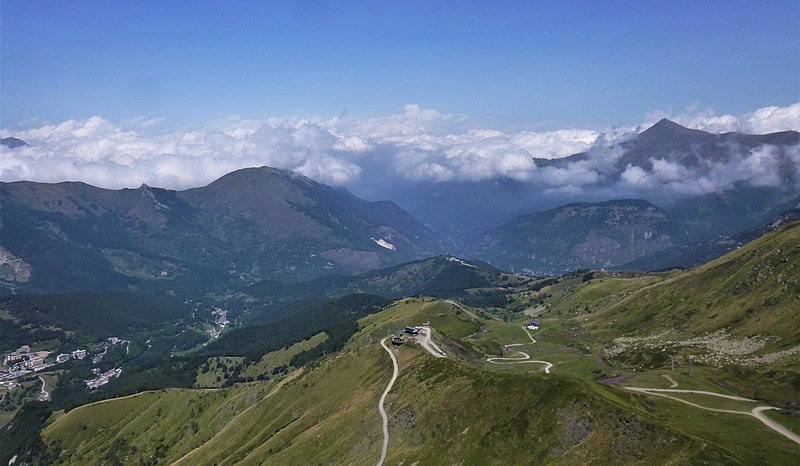ROBERTA FERRARIS
Located at the extreme South-East corner of the Occitan-speaking area, Vermenagna Valley is a borderland for several aspects: it borders with France through the Col di Tenda (a high mountain pass) which also separates Ligurian Alps from Maritime Alps. Along the alpine ridge one finds the ruins of those fortifications built between the 19th century and the 2nd world war, which had never been used for their purpose. The area also marks the border between two natural environments: the strictly alpine one and the Mediterranean one of nearby Provence.
Visiting route
From Borgo S. Dalmazzo the state road SS 20 crosses the river Gesso and goes up to Roccavione, village rising at the beginning of the valley where Gesso and Vermenagna torrents meet. The village is dominated by the Rocca di S. Sudario, a mountain top with the ruins of a medieval tower. In the 13th century, Roccavione was the refuge for a heretic Cathar community and its bishop coming from Provence. In summer, an historical reconstruction reminds those medieval events.
The village experienced an important industrial development in the late 19th and 20th centuries (spinning mills, cement factories, paper factories) exploiting the abundance of running water and local building materials such as schists. In the first half of the 20thcentury, Roccavione became also a popular summer holiday resort. Today, about fifteen Belle Époque villas and some monumental trees – among them some sequoias – in the park of the Salazar counts remind that wealthy past.
The state road crosses the industrial zone at the feet of some quarries and then reaches Robilante in a wide part of the valley on the left side of river Vermenagna. As happened for Roccavione, the village underwent an industrial development in the 20th century which today has been significantly reduced. The territory has a vocation for tourism with several hiking offers especially across the chestnut woods characterizing the valley where it is possible to find houses with the local rye-thatched roofs. Robilante hosts the Museo della fisarmonica, della musica e dell’arte popolare (Museum of accordion, popular music and art) dedicated to the accordionist and craftsman Giuseppe Vallauri, known as Nòto Sonador (1896-1984) and to the carver Giorgio Bertaina, Jors de Snive (1902-1976). Among handicraft traditions still alive in Vermenagna Valley one has to mention the art of “cultlè”, the knife craftsmen, making the «vernantin», small handmade knifes with steel blade and ox or ram bone handle: a «vernantin» collection is available for visit in Robilante by the cultural association “pro-loco”.
The visit continues following the state road and reaching Vernante. In the village, around 90 house walls are decorated with mural works of art dedicated to scenes of Pinocchio. Attilio Mussino, the historic illustrator of the Pinocchio tale by Collodi, was from Turin but has lived for a long time in Vernante. The Attilio Mussino Museum is hosted in the rooms of the former Confraternity and collects original illustrations composed for the 1911 Bemporad edition which are also those reproduced in the mural works of art. The information point of the Marittime Alps Natural Park is located in Via Umberto I and it is open in summer with an exposition dedicated to the beechwood of Palanfrè and to mountain pasture activities. Behind the village stands the «Turusela», the ruins of the Lascaris castle, built in the 13th century to control the way toward Col di Tenda.
From Vernante, taking the provincial road SP 278 toward Val Grande one reaches Palanfrè, access point to the Maritime Alps Natural Park. From this hamlet, which maintains some valuable buildings, a Nature Trail brings into an ancient beechwood, which has been preserved since the 18th century and is rich of centuries-old trees. From Vernante (near the Bec Moler area), it is possible to reach Palanfrè on foot following the path named «La via di tèit», which passes trough several hamlets today abandoned.
The SS 20 road brings to Limone Piemonte, an historic ski resort since 1907 at the foot of Mirauda Peak (2157 m) and Rocca dell’Abisso (2755 m). The village has been known since the 10th century when it was destroyed by the Saracens. Today, the town architecture presents a modern style due to the presence of several tourist settlements. The historical centre keeps the gothic S. Pietro in Vincoli church built in 1363. From the village a side road brings to Limonetto: this hamlet is an access point to the ski area of Limone. In summer, Limonetto is the starting point of the hiking network «Lu Viasol», including seven easy foot paths. One of those follows the ancient roman route to Col di Tenda.
From Limone, the road SS 20 continues toward the Col di Tenda tunnel. Inaugurated in 1882, it connects Val Vermenagna to Val Roia, Ventimiglia and Provence. The old road to Col di Tenda follows one of the ancient salt roads (La via del sale) and was built between the 18th and 19th century. It is not carriageable due to the steep French slope including 48 hairpin bends: a real mule track. This old road together with the network of military roads near the mountain ridge are today an interesting mountain bike trail allowing the visit of old military forts, such as the Central fort watching over the pass at 1908 m.
The historic railway Cuneo-Nice
It was Camillo Benso di Cavour in 1853 to propose to the Parlament of the Reign of Sardinia the construction of a railway connecting Cuneo to Nice, at the time still belonging to Italian territory. When Nice and Cotê d’Azur passed to France in 1860, a new project planned to reach Ventimiglia instead, leaving a small part toward Nice from Breil-sur-Roya. However, due to the complex region orography, the first part of the railway, the Cuneo-Limone Piemonte, was completed only in 1891. Construction of the railway resulted to be very complicated, the works stopped during the 1stworld war and the line was completed in the 1930s. The railway became very important for both the ski resort of Limone Piemonte and the Ligurian and Provençal littoral resorts: an international train used to reach Sanremo and Nice from Switzerland in 12 hours. The line was heavily damaged during the 2nd world war and it was reopened only in 1979. The Cuneo-Nice line is an engineering success, considered one of the most daring railways of Europe: it is 96 km long and includes 81 tunnels and works of arts of remarkable importance.


